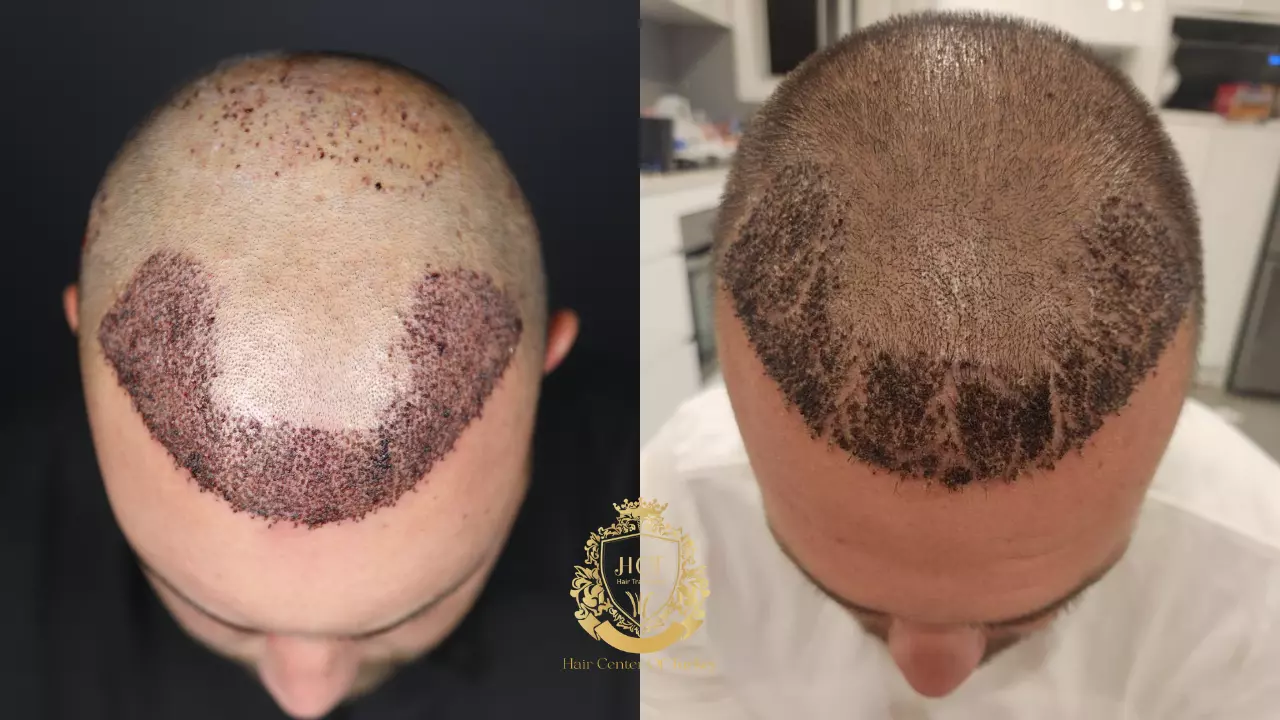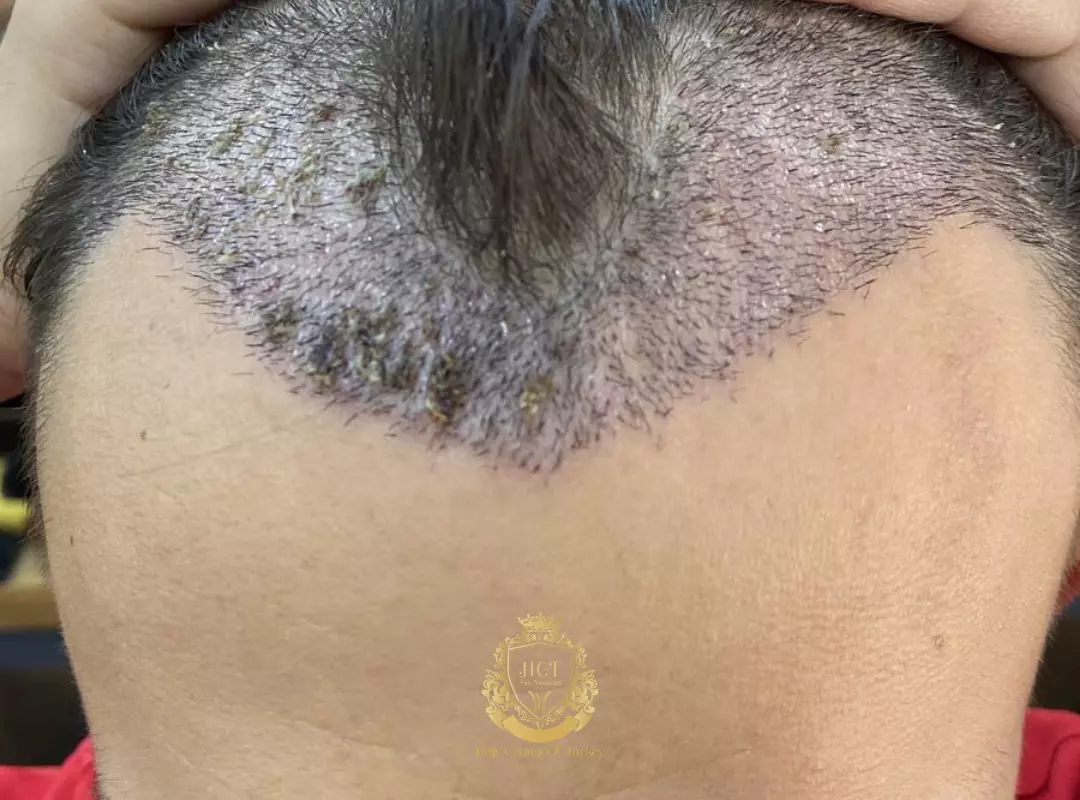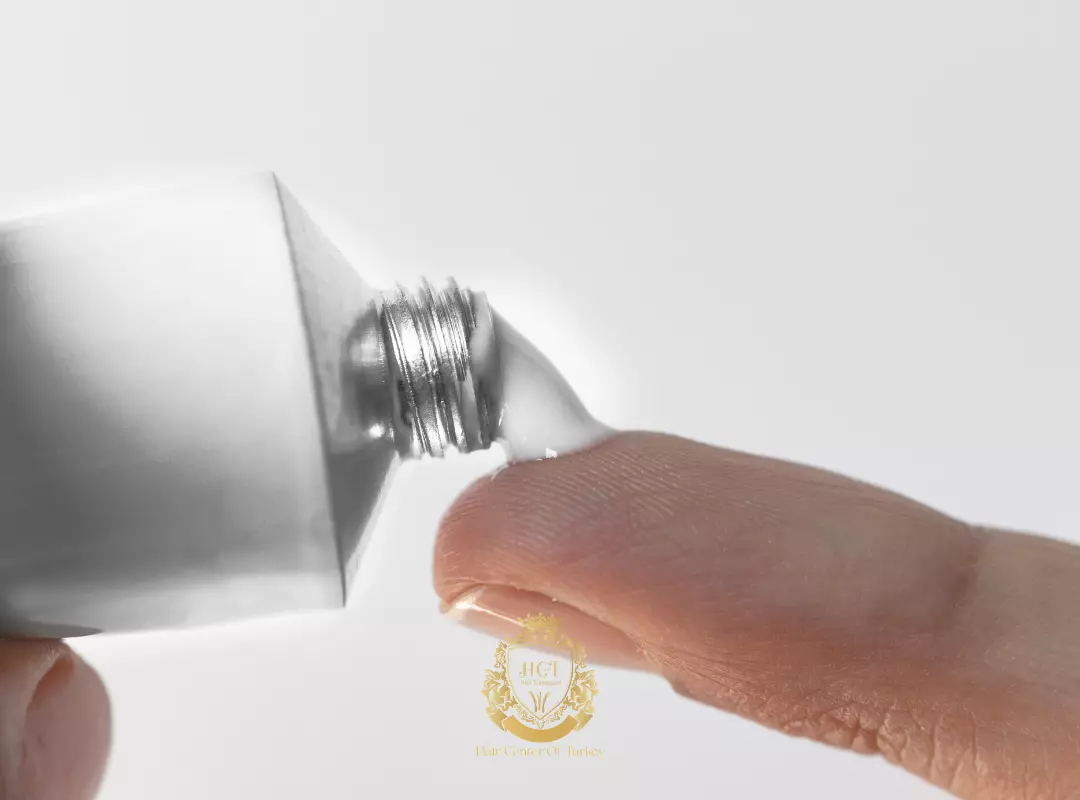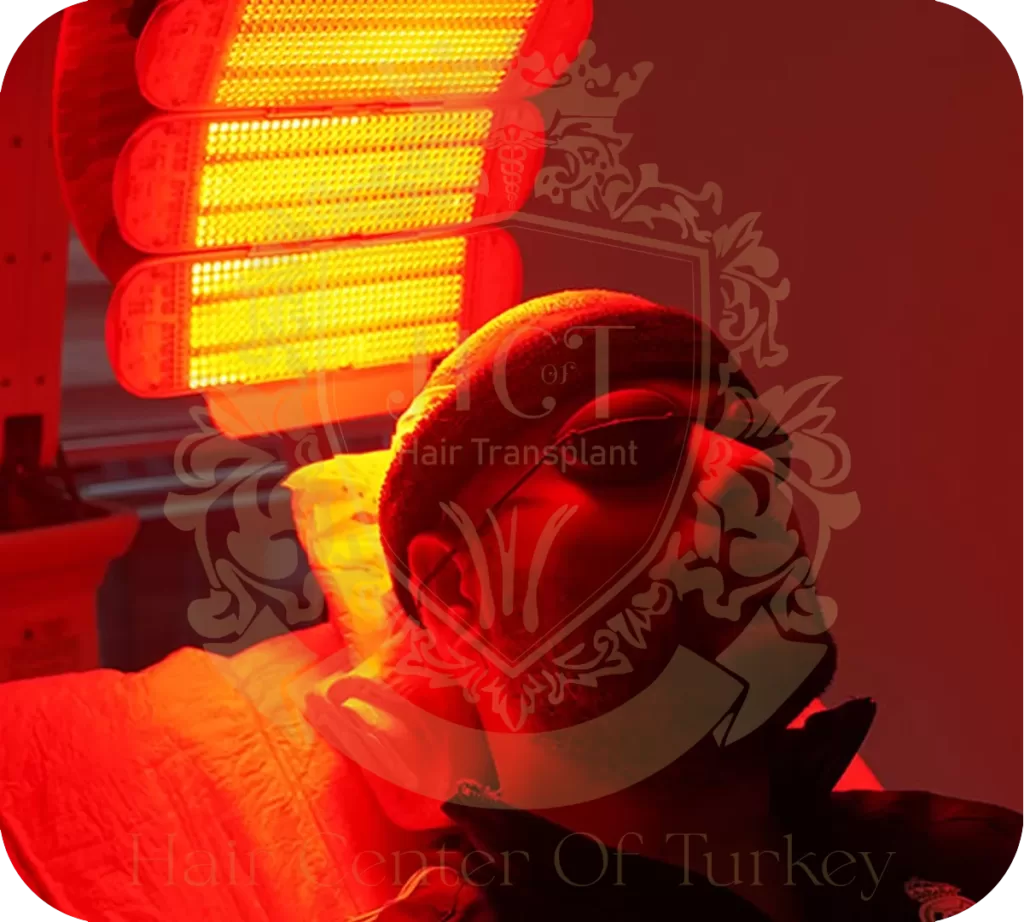Are you experiencing hair loss problems? Meet hair transplantation, the clearest solution to hair loss. Send us a message for detailed information and free consultation.
What is Crusting After Hair Transplant?
Hair follicles taken from the patient undergoing a hair transplant are transplanted into the channels opened. The hair follicles, which are also implanted, cause the formation of small holes in the scalp. In these tiny holes formed as a result of the transplant of hair follicles, a small amount of body fluid and blood leaks occur. The layer formed by these dried leaks is called crusting after a hair transplant.
Crusting seen in every hair transplant operation is a normal process after the operation. The speed of crusting after a hair transplant ensures healing. There is nothing scary about crusting, which can be uncomfortable. The scales, which have a scaly appearance, occur as a natural reflex of the body. They function in the same way as scabs that appear in other parts of the body due to bleeding.
Most patients develop scabs within the first 24 hours after transplant. Crusting, which may be accompanied by redness and swelling, should not be confused with dry skin fragments. After hair transplant, dry skin pieces, which are easily recognized with the care spray given to the patient, should not be plucked and should not be damaged in any way.
The same applies to crusting after a hair transplant. Brown or black crusts are part of the healthy healing process.
Operations in which hair transplant techniques such as DHI, FUE, and hybrid are preferred should take place in extremely meticulous environments. If specialist doctors are preferred, the formation of crusting after hair transplant will be at an ideal level. If the rules about transplant are not followed and not treated sensitively, the formation of crusts will increase and the healing time will be delayed. It is necessary to be patient for an average of 10 days until the transplanted hair follicles are damaged.
Causes of Excessive Crusting After Hair Transplant
There is more than one reason for crusting, which is more common in some people. Situations such as genetic factors can make the reactions of the person’s body different.
The two biggest reasons for more crusting after a hair transplant are alcohol and smoking. These habits, which should be quit 1 week before the operation, should also be quit 1 week after the hair transplant is completed.
Apart from all these reasons, care should be taken to take meticulous care of the donor and transplant areas. The crusts should not be scratched or tried to be removed.

What Causes Crusting After Hair Transplant?
The injury that occurs in any part of our body undergoes a crusting period in the progressive process. This measure taken by the body against damaging microbes from the outside emerges for protective purposes. The crusting that occurs as a result of injury in other parts of the body also acts as a protection mechanism.
More than one method is preferred during hair transplant. In hair transplant operations performed with modern techniques such as FUE, DHI, and hybrid, hair follicles are taken from the donor area. The follicles are transplanted to the area experiencing hair loss. The channels and incisions opened during the transplant cause minor bleeding. The bleeding dries and is replaced by clots. Then crusting occurs in the transplant area.
The crusting after the operation takes place between 24 and 72 hours. In this time interval, bleeding and tissue fluids stop leaking from the incisions and appear as small scabs on the scalp.
Crusting after a hair transplant shows that the healing is going in a positive direction. If a patient has excessive crusting after a hair transplant, he/she should consult a doctor. The general causes of excessive crusting are known as alcohol, smoking and blood thinners. These habits, which should be quite 1 week before the operation, cause excessive crusting after a hair transplant. Alcohol and smoking should be stopped for a certain period of time after the operation. Increased crusting, which is also caused by the patient’s health problems, should be overcome with the advice of a doctor.
As a result, crusting is an extremely normal phase to be experienced after a hair transplant. This condition, which will last an average of 10 days, can take a shorter time if the patient follows the recommendations.
Things to Consider About Crusting After Hair Transplant
It takes an average of 1 year to get the clearest result in a hair transplant, which is a permanent solution for hair loss. The most critical period of this time interval is the first 2 weeks after transplant. During this period when some activities should be avoided, scabs occur on the scalp. The points to consider about crusting after a hair transplant are more than one. The most striking points can be shown as the following.
It is necessary to avoid any contact with scabs that will cause intense itching on the scalp. This action, which will delay the healing time, may cause long-term damage for a short-term need.
The crusts that occur in the donor area and hair follicles should not be torn off with nails or hands. This action, which will cause damage to the transplanted hair follicles, may dislocate the hair strands and negatively affect the result.
The last thing to be considered about crusting after a hair transplant is washing. Care should be taken to use the shampoo and lotion that should be taken according to the doctor’s recommendation. If all these rules are followed and something negative is encountered, the doctor should be consulted.
As a result, crusting after a hair transplant is not harmful.

How Does Crusting Fall After Hair Transplant?
Crusting after a hair transplant occurs on average between 24 and 72 hours. The crusts, which are tightly attached to the scalp, may cause an intense itching. Plucking, lifting, scraping or scratching the scabs with the help of fingernails or hands should be avoided. Any of these actions will prolong the healing time. In addition to this, there are damages that extend to the displacement of the hair follicles and even the rupture of the transplanted hair follicles.
Therefore, applying force to the scalp should be avoided and the scab formed after hair transplant should be expected to fall off spontaneously. During this process, the doctor’s advice should be strictly followed.
When Does Crusting Fall After Hair Transplant?
It should be known that the first 2 weeks after a hair transplant are very important to get a positive result. Crusting is of great importance in order to prevent inflammation and to prevent the areas treated in the operation from getting infected. The crusting, which allows healthy healing, continues for 10 days after transplant. It is recommended not to touch the scalp for the first 4 days.
The day after the operation is completed, the first wash is usually performed. Important warnings are given to the patient during the first washing by the experts. How the person will wash his/her hair is explained and shown in detail. Hair that should not be rinsed with pressurized hot water should be washed with warm water in small containers.
Scalp massages should be supported with special shampoos and lotions recommended by the doctor. Care should be taken not to apply too much pressure during massage. Possible absent-mindedness can dislodge the hair follicles.
The scabs, which are a brown, hard layer, begin to form with the completion of coagulation and the appearance of mild redness. After the hair transplant process is completed, the crusting continues until the tenth day. After this period, the crusts that begin to loosen begin to fall off spontaneously between 7 and 14 days on average. The falling interval, which varies according to the amount of grafts transplanted, the density and the size of the area, may vary from person to person. At the end of 14 days, if the crusts in the transplanted area do not fall off, a doctor should be consulted.
A patient who has completed the reduction of crusting after a hair transplant can continue to wash his/her hair with another shampoo he/she prefers with the approval of his/her doctor.

Medicines for Crusting After Hair Transplant
Medications for scabbing after a hair transplant should be used with the doctor’s advice. After the hair transplant process is completed, the transplant area and the donor area where the hair is taken are cleaned and bandaged. Clean bandages used to prevent germs and reduce blood flow do not affect the formation of crusting.
Special shampoos and creams should be used for the scabs to soften and fall off spontaneously and in a healthy way. You can use cream with the doctor’s approval to protect the donor area from infections and to heal the wounds faster.
People with chronic diseases such as diabetes, hypertension, and hormone disorders should be consulted with specialists.
Although medications play an important role in scabs after hair transplant, not washing the hair properly can damage the hair follicles. In order to wash the hair correctly and not damage the scabs, lotion with a softening structure should be used. The lotion, which should be massaged into the scalp, should be kept for an average of 30 to 45 minutes. During washing, care should be taken not to interfere with the transplanted area with hands or nails. After 45 minutes of waiting, the crusts feel soft with the effect of the lotion. After waiting at the required level, the scalp with lotion is cleaned using warm water.
After the lotion cleansing process is completed, a small amount of shampoo is sprayed on a non-transplanted area. After foaming the area sufficiently, the tampon technique is applied to the transplanted area. The area, which should be cleaned with light and delicate movements, should be rinsed with warm water.
After washing, the patient should gently dry a soft towel without rubbing the transplanted area. It can only be placed on the hair and dried as a tampon. A patient who regularly uses medications for crusting after a hair transplant will notice that the crusts decrease after each wash.
FAQ (Frequently Asked Questions)
As a result of drying of substances such as blood or body fluid resulting from the hair transplant operation, scabs appear on the scalp. This is part of the healing process.
Scabbing is not dangerous. On the contrary, it accelerates the healing process. The amount of scabbing also varies from person to person. Scabbing occurs more in people who consume alcohol and smoke. Scabs should not be removed by scratching.
Post-operative scabbing appears within 2-3 days. The patient is taught how to wash his hair. 10 days after the operation, the scabs should be removed with gentle movements while washing. The spray and shampoo recommended by the doctor should be used.
On the 10th day of the operation, the scabs should be removed with gentle movements during washing. The scabs that cannot be removed during washing will fall off on their own in the coming days. If the scabs have not fallen off 14 days after the operation, consult your doctor.
PDF & Voice Introduction
Contents
Reach our consultants team
Our Address :
Ataköy 7-8-9-10, Selenium Retro, D-100 Güney Yanyolu No:18/A, 34158 Bakırköy/İstanbul
Get more information for hair transplant!


